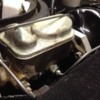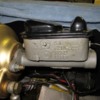The E2TA casting number crosses to Dorman #M39388, which is a '83 - '85 Ford Ranger and Bronco II master. But its not a Ranger/Bronco master. If a person buys the replacement master that the E2TA number crosses over to, you'll end up with a cast iron master designed for drum rear brakes.
The most likely way to source the master at your local parts shop is to ask for a master for a 1984 - 1986 Ford SVO Mustang turbo-charged 4 cylinder. Don't be surprised if the replacement is made of steel instead of aluminum. It may have a 1.125" bore and should require IPSCO adapter number IPS001, Jamey I see an adaptor sandwiched between your power brake booster and the master.
In general, a master designed for a high performance Ford equipped with rear disk brakes, such as a GT Mustang or SVO Mustang, should get you something close. Hall Pantera and Dennis Quella were SVO parts dealerships ... perhaps the first thing to do is give Tara or Dennis a call and ask if they still have this master on the shelf.
There are 5 considerations in choosing a master.
• The oem master has a different mounting flange bolt pattern than the Ford masters (or GM masters). A mounting flange adapter is required between the master and the vacuum booster to adjust for the differences in bolt pattern.
• The oem master had a 23mm piston, which is about 0.900". The oem/aftermarket/retrofit Ford masters come in two piston sizes, 1.000" for use with a brake booster, and 1-1/8" for use without a brake booster.
• It appears the masters designed for 4 wheel disk brakes are a bit different than the masters designed for front disk/rear drum applications. That difference may be the check valves designed to hold back a tiny bit of pressure.
• Some masters have ports threaded for SAE tube fittings, others have ports threaded for metric tube fittings. 1979 through 1986 Mustangs had SAE fittings. Beginning 1987 they had metric fittings.
• Brass tube fitting thread conversion adapters are available. You'll notice a lot of these aluminum Ford masters, such as yours, have adapters screwed into the outlet ports, because the Pantera fittings are metric but the master was machined for SAE fittings. This tells you the current master may have been originally designed for a pre-1987 application.
Since your car is already equipped with the mounting flange adapter, then its ready for a Ford master. You'll want one with a 1.000" piston (designed for use with a booster) and designed for 4 wheel disk brakes. If you want to keep the same tube fitting arrangement, you'll need to figure out what type of adapters are fitted to your Pantera's master. For SAE ports, purchase a master for pre-1987 Mustangs. For metric ports, purchase a master for 1987 or later Mustangs.
You'll find a selection of brake parts at the parts houses that supply parts for rear disk brake conversions. There is a nice looking aftermarket Ford master on the market having plastic reservoirs, it kinda looks like the oem master. Wilwood also has some nice masters available. And of course, oem masters are available from Wilkinson.
The 1996 SVO catalog lists part number M-2032-R58. The price list refers to this master as a 1995 Cobra Mustang master. Its not pictured or listed in the catalog itself, just in the price list. That may provide a way to spec a more recent master at the local parts store.
-G



